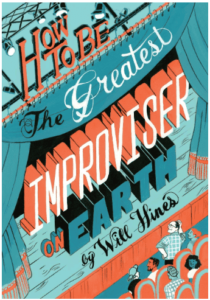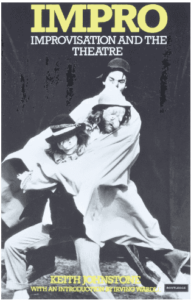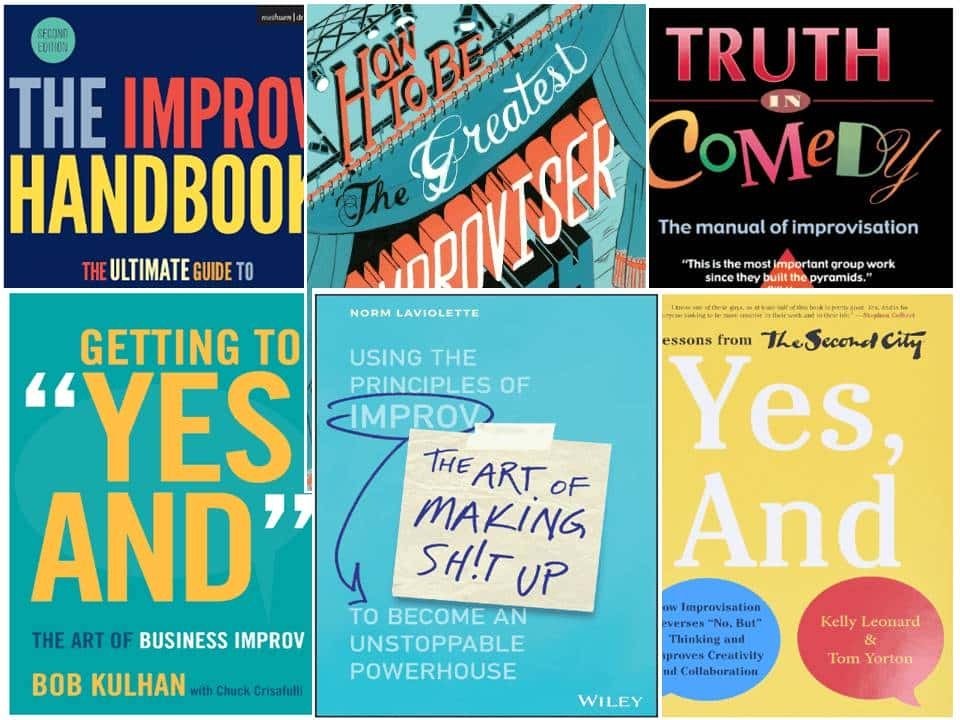The best Improv books to read for work and the online link to these books are available in this post. Readers can learn how to act spontaneously in improvised scenarios by using improv books as guidelines. These manuals address issues like accepting curiosity, actively listening and observing body language, and getting over self-consciousness and failure-related fears. Actors are known to read these books the most, but you can also use them in the workplace to help employees become better problem solvers and responders, as well as to foster a stronger sense of teamwork.
These manuals can enhance teamwork inside the workplace and increase the effectiveness of Zoom improv and large group improv games. These books are comparable to books about creativity and innovation.
List of Best Improv Books
A list of the best Improv books to read for work and the online link to these books are available here. To enhance collaboration, dialogue, and judgment, read these books on improv for work:
1. Yes, And: How Improvisation Reverses “No, but” Thinking and Improves Creativity and Collaboration by Kelly Leonard and Tom Yorton

The Second City’s directors, one of the best improv groups in the world, did write it. The writers demonstrate how developing improvisational skills might improve job performance by applying the principles of improv to the workplace. The pages offer guidance on innovation, change management, and team building by utilizing the technique of acting off-script. Yes, and it demonstrates to readers how to maintain an optimistic outlook and an open mind, as well as how to read and listen to body language, build rapport, work well with others, and not be scared to try new things.
To read the book, click the link: “Yes And.“
2. The Art of Making Sh!t Up: Using the Principles of Improv to Become an Unstoppable Powerhouse by Norm Laviolette

The Art of Making Sh!t Up demonstrates how to use improv to improve your ability to present and your general productivity at work. Norm Laviolette explains how to use improv in the workplace and demonstrates how it can increase inclusivity, productivity, and enthusiasm among employees. The book offers advice on how to overcome self-doubt, trust your gut, learn from mistakes, become more tolerant of uncomfortable situations, and build on the ideas of others. Readers who read The Art of Making Sh!t Up will gain the ability to accept ambiguity, get over impostor syndrome, and relish the process of impromptu invention.
To read the book, click the link: “The Art of Making Sh!t Up“
3. Getting to “Yes And”: The Art of Business Improv by Bob Kulhan and Chuck Crisafulli

One of the best books on business improv is Getting to “Yes And.” The book gives examples of how to use improv techniques in business settings. The writers clarify that teamwork, problem-solving, brainstorming, and conflict resolution may all be enhanced by adopting the same attitudes and actions that make improv situations interesting. The chapters focus on improvisational ideas like being open-minded to opportunities and having consistent energy that is most useful in the corporate world. Professionals can learn how to adjust to change and respond to the unexpected without losing their cool by reading “Getting to “Yes And.”
To read the book, click the link: Getting to “Yes And.”
4. Truth in Comedy: The Manual for Improvisation by Charna Halpern, Del Close, and Kim Howard Johnson

One of the most frequently suggested improv books for novices is Truth in Comedy. The book offers guidelines for producing improvised scenarios on the spot and examines their fundamental components. The writers placed a strong focus on collaborative projects and storytelling—two ideas that are applicable in the workplace. Similar pertinent work themes like trust, agreement, and environmental awareness are also covered in some of the chapters. The pages include multiple tasks designed to help participants hone the abilities and intuition needed to create on the fly and respond without thinking things through.
To read the book, click the link: “Truth in Comedy“
5. How to be the Greatest Improviser on Earth by Will Hines

The book How to Be the Greatest Improviser on Earth is a guide for improvisers written by Will Hines, who is a teacher and member of the Upright Citizens Brigade Theatre. Hines draws from his many years of experience to guide improvising, and while the book focuses mostly on comedy, some pearls of wisdom apply to the workplace as well. These include staying present, being adaptive and flexible, knowing what drives conflict, and acting boldly and confidently. The book stresses authenticity and demonstrates how to use innate talents and instincts to connect more deeply and resonate with your audience.
To read the book, click the link: “How to Be the Greatest Improviser on Earth“
6. The Improv Handbook: The Ultimate Guide to Improvising in Comedy, Theatre, and Beyond by Tom Salinsky and Deborah Frances-White

One of the best improv books for novices is The Improv Handbook. This book serves as a thorough introduction to the world of improv and addresses a wide range of subjects, including how to teach improv to the business sector and the fundamentals of scene work and public performance. The book’s last portion is a collection of interviews with well-known improvisers who share tips for honing the art. The Improv Handbook offers advice on cooperating, giving up control, putting your trust in partners, and gradually building a bigger story.
To read the book, click the link: “The Improv Handbook“
7. Impro: Improvisation and the Theatre by Keith Johnstone
Without Impro, no list of improv books could be considered comprehensive. This piece is frequently cited as one of the best resources for learning improv. The book is divided into four primary sections: mask & trance, storytelling skills, spontaneity, and status. There are moments when the wording is complex and the tone is intellectual. Nonetheless, the book offers a wealth of enlightening observations about the nature of creativity, the value of spontaneity, and strategies for captivating and persuading audiences.

Despite being directed towards the theater industry, this book is also useful in the workplace, especially for those in sales, marketing, and advertising. In reality, many of Keith Johnstone’s career-boosting advice pieces can also be used as strategies for achieving professional success. Daniel Pink even mentions this method in his book To Sell is Human. Impro provides readers with a behavioral and psychological backdrop for the world of improv, demonstrates how to cultivate and enhance the discipline, and explains how to apply these ideas to other facets of life.
To read the book, click the link: “Impro: Improvisation and the Theatre“
8. Improv Wisdom: Don’t Prepare, Just Show Up by Patricia Ryan Madson

Improv Wisdom is a compilation of useful life guidance derived from improv. Patricia Ryan identifies thirteen important lessons to be learned from the work of art, including starting somewhere, paying attention, and looking out for one another. Every chapter delves deeply into the driving idea and offers inspirational sayings to inspire readers to follow their instincts and take chances. The book disproves the notion that every detail should be planned and prepared, demonstrating instead that often the most progress results from acting in the face of uncertainty. Professionals rarely have ideal circumstances or full information when they are working, so being able to react quickly is a useful skill. Improv Wisdom describes how readers can gain from practicing improvisation and highlights the mental and emotional benefits of doing so.
To read the book, click the link: “Improv Wisdom“
9. Improvise: Scene from the Inside Out by Mick Napier

Improvise: Scene from the Inside Out defies improv conventions. According to Mick Napier, improv’s golden principles can cause actors to overthink a scene and make it uninteresting. This handbook demonstrates that magic occurs when performers know when and how to defy expectations, a notion that carries over into the professional world. The book looks at how to identify and fix typical issues in scenes, direct the narrative, build rapport with a partner, and make good use of context. Improvise: One of the best instances of putting improv theories into reality is Scene from the Inside Out, which provides readers with a set of flexible principles and critical thinking abilities instead of rigid restrictions.
To read the book, click the link: “Improvise: Scene from the Inside Out“
Improv books aren’t just for performers. Numerous lessons for the business world, interpersonal relationships, and life in general can be found within the pages of these manuals. These books educate readers on how to communicate nonverbally, watch and remain awake, get over their fear of making mistakes or looking silly, and react quickly. These resources demonstrate that brilliance can also come from exploration and spontaneous creation rather than from meticulous planning and methodical execution. The books equip readers with the knowledge and abilities needed to respond quickly, communicate more clearly, encourage and depend on team members, and exhibit innovation with ease.
FAQ’s
What are the best improv books for comedy?
The best improv books for comedy are Truth in Comedy by Charna Halpern, Del Close, and Kim Howard Johnson. The Improv Handbook by Tom Salinsky and Deborah Frances-White, Impro by Keith Johnstone, and How to Be the Greatest Improviser on Earth by Will Hines.
Does reading help with improv?
There are several advantages to reading improv books at work, such as enhanced teamwork, quicker thinking and problem-solving, and better communication. These books can help strengthen readers’ team dynamics and enhance their ability to behave spontaneously during improv exercises.







